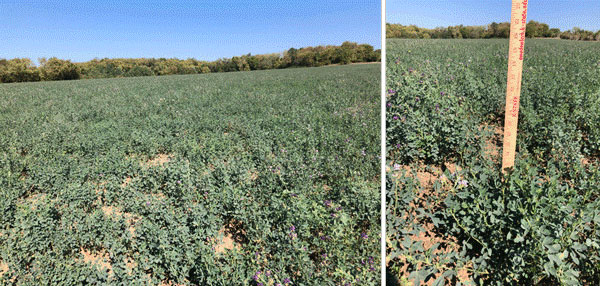A recent eUpdate article from early September discussed the best time for the last cuttings of alfalfa ahead of the winter months (https://eupdate.agronomy.ksu.edu/article/alfalfa-management-deciding-on-the-last-cutting-this-fall-607-4). The decision should be weather-based at this time of the year because the timing of the last two cuttings impacts the winter survival and productivity of the stand in the following year.
This article answers some questions about the last cutting for stands that are shorter than normal or under drought stress (Figure 1).
What if the alfalfa stand is short (less than 12 inches)?
In this case, the recommendation would be to avoid cutting it as the alfalfa tonnage would likely be low enough, not justifying costs. Additionally, avoiding cutting a short stand of alfalfa if there is insufficient growth to warrant harvesting from an economic standpoint actually helps the stand. This decision may also depend on stand thickness, but there should be about 12 to 15 inches of plant height to warrant harvesting. If there isn’t that much growth, wait for sufficient second growth once rainfall is received.

Figure 1. Alfalfa field in northeast Kansas with reduced stand height. Photos by David Hallauer, K-State Research and Extension.
What are the best management options for drought-stressed alfalfa stands?
Is it too late to cut a stand now, assuming there won’t be a hard freeze until November?
Always use caution when harvesting alfalfa in the fall, especially if the plant is already drought-stressed. Cutting the crop without leaving 6-8 weeks of re-growth before the first freeze can damage the stand and reduce persistence for subsequent years. Here, growers should base the anticipated timing of the freeze event on the average freeze date for their location and not count on a later date. Thus, if the crop is drought-stressed, the most appropriate management would be to wait until a good hard freeze before harvesting it. If yield is limiting enough not to cover harvest costs later in the fall, an option would be to graze after a hard freeze event (below 25F for 4+ hours). These measures would give the stand the best possible situation going into the fall. That way, you will have a good stand and (hopefully) precipitation to work with the next year.
Should I keep the thinning stand?
Alfalfa stands decline in both tonnage and quality as they age and thin. Stands past their economically productive life also serve as a weed and disease source for surrounding fields. Operators should carefully weigh their projected returns from rotating out of alfalfa to maximize profit. Fields having less than four to five plants per square foot are considered poor and should be rotated. Another method is counting the number of stems per square foot when growth is around 5 inches tall. More than 55 stems per square foot indicate that yields are not limited, 40 to 55 stems indicate yields are somewhat limited, and fields with less than 40 stems per square foot should be considered for rotation.
“Rule of Hat” Method: If you do not have a measuring square, a standard baseball cap with brim measures approximately half a square foot, so stem counts can be doubled or threshold halved. For example, if 30 stems are counted under the hat, then multiply 30 by 2 to estimate 60 stems per square foot.
Romulo Lollato, Wheat and Forage Specialist
lollato@ksu.edu
John Holman, Cropping Systems Agronomist – Garden City
jholman@ksu.edu
Tina Sullivan, Northeast Area Agronomist
tsullivan@ksu.edu
Tags: alfalfa Drought forage short stands